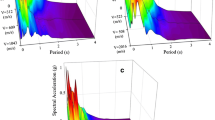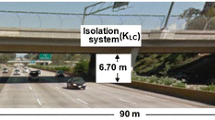Abstract
Seismic isolation technology is an effective mean of reducing seismic risk and enhancing the structural seismic performance. However, some parameters affect and mitigate the efficiency of this technology: earthquake inputs and soil characteristics. The main purpose of this study is to investigate the simultaneous effects of different records and flexible soils on isolated bridges. For this reason, an isolated bridge is assumed to be at different distances from the ruptured fault (Rrup) to represent the near-fault (NF) and far-field (FF) situations. These records are extracted on different soils which are categorized based on their shear velocity to represent different soils’ behaviors and characteristics. Nonlinear time history analyses (NTHAs) are carried out on a typical isolated bridge model with the SAP2000 software. Responses in terms of deck acceleration, base shear, displacement and the performance of the isolation units are studied. Results demonstrate that for NF zones, the consideration of the soil effects is imperative. In soft soils, all seismic responses are amplified, leading to higher force and displacement demands. In such zones, not considering this fact during the design, results in largely insufficient displacement and force capacities of the isolated bridge system are seriously harming its seismic performance.
Access provided by Autonomous University of Puebla. Download conference paper PDF
Similar content being viewed by others
Keywords
1 Introduction
Seismic isolation technology is based on decreasing the fundamental frequency of the structural vibration to a value less than the predominant energy-containing frequencies of the earthquake in order to reduce the seismic force demand to or near the elastic capacity of the structural members, thereby eliminating or drastically reducing inelastic deformations (Soneji 2008). According to the recent studies and based on the evidences from past earthquakes, record characteristics and soil effects are two among the most important parameters impacting the seismic performance of the isolated structures (Roussis 2003; Jonsson 2010). Ground motion records obtained in major earthquakes have shown that the characteristics of NF are particularly different from FF records. NF records often contain strong and long period velocity pulses that could cause severe structural damages (Galal and Naimi 2008; Choi 2010). These records change drastically in their frequency contents by passing through the different soils and can be more destructive for infrastructures located on soft soils leading to higher demand in terms of displacements and shear forces by negatively influencing the isolated system (Worku 2014; Castaldo and Ripani 2016; Castaldo and Tubaldi 2018). Different methods and software programs were used to provide reliable soil models and structural behaviors to help researchers and designers attain more dependable predictions of bridges’ seismic performances. Soil materials exhibit a diverse range of complex constitutive behaviors, which makes the development of numerical models quite challenging (Beresnev 1996; Neethu and Das 2018). Some soils exhibit nonlinear behavior with gradual softening, which manifests as a decrease in shear modulus with increasing strain. Previous studies have demonstrated the effects of soft soils on seismic responses of bridges, and they showed that neglecting the soil effects leads to underestimating the bridge damage potential (Soneji 2008; Castaldo and Ripani 2016; Chouw and Hao 2005). According to few studies, seismically isolated bridges are very sensitive to NF records and soft soil effects (Castaldo and Ripani 2016; Liao 2004). The objective of this study is to investigate the simultaneous effects of record characteristics including NF and FF on different soils with the changing of the frequency of records based on their characteristics according to the Canadian Standards Association (CSA 6-14) (CHBDC 2014).
2 Selected Records and Case Study Bridge Model
Twenty-one (21) records of Northridge (1994), Kobe (1995) and Parkfield (2004) earthquakes were extracted from the PEER database Web site (PEER Homepage 2019). These earthquakes were chosen because they are among the most destructive earthquakes. Additionally, there is a rich database of these records at different distances from the epicenter, Rrup, to represent NF and FF situations as well as soil types to represent the soil effects. Records were chosen nearly at the same distances and soil classes for all three earthquakes. The purpose of using real measured records is to better take into account the observed changes in the records’ characteristics by passing through the different soil layers instead of software predictions. Records and site classes are classified according to the CSA 6–14. Nine (9) of the 21 records are in a distance of 10 km from the epicenter (Rrup less than 10 km) and are considered as NF records. NF records have higher characteristic values especially in terms of peak ground velocity (PGV), specific energy density and damage index. These features cause higher seismic responses, and such signals impose a very high input energy to the structure at the early stages of the records (Liao 2004). As the main purpose of this study is to investigate the simultaneous effects of NF and FF on different soils, the effect of different source mechanisms is not considered. Spectral accelerations of Northridge earthquake, as an illustration of the effects of different soil classes on records’ characteristics extracted from PEER, are shown in Fig. 1. Drastic changes in the maximum response acceleration and period elongation in soft soils are observed and point out the importance of considering soil classes for the seismic analysis of bridges.
The selected case study bridge with conventional and isolated designs is chosen from Alper Ucak’s research work (Ucak and Tsopelas 2008). The bridge has two equal spans supported on a circular 30 MPa concrete pier with 5.2-m height and 1.1-m diameter. The deck is a uniform solid slab with a total mass of 265 KN. The isolation system is designed for a period T = 2.0 s, and the displacement capacity of the isolator is 7.0 cm. Assuming the bridge is in Montreal, Canada, the hysteresis parameters, the behavior of the isolation system and the bridge 3D model are shown in Fig. 1. The isolation system is lumped at the central pier (free moving bearings at abutments and fixed base of the pier), and only the longitudinal direction is studied. NTHAs were conducted in SAP2000 (Wilson 2017). The results are discussed in the following section.
3 Results
The isolation hysteresis loops, obtained from NTHA, are shown in Fig. 2. They illustrate that the isolator displacement and energy dissipation allocate the highest amounts on soft soils and NF records. The dissipated energies within the hysteresis loops as well as shear forces are higher for the mentioned condition. In FF areas, the farther the distance away from a ruptured fault results in higher responses and displacement demands on soft soils. The maximum acceleration and isolation displacement responses for Kobe records are presented in Fig. 3. It is obvious that the seismic isolation has considerably reduced the seismic acceleration forces by a factor up to 10 in stiff soils, while this factor is only 2 in soft soils for FF records which shows that maximum reduction is obtained for stiff soils.
The maximum deck displacements for isolated bridges are 27.2, 15.9 and 6.7 cm for Kobe, Northridge and Parkfield records, respectively, and they are related to NF on soft soils’ records. It should be mentioned that more than 95% of the deck displacement takes place within the seismic isolation system. In the case of Kobe and Northridge records, the isolator displacements are nearly 4 and 2 times more than the isolator displacement capacity, which is 7 cm. This shows that the amount of isolation displacement demand is higher in NF zones, especially on soft soils. This trend is the same for base shear responses, and the maximum responses are related to NF records on soft soils. As it is shown in Table 1, in NF zone (R = 0.9 km), the base shear force increased nearly 3 times (28,000 N vs. 10,500 N) in soft soils (Vs = 312 m/s) compared to stiff soils (Vs = 1045 m/s) in the case of Kobe records. For the other two earthquakes, the trend is the same by a factor of 2.
4 Conclusions
The seismic responses of an isolated bridge subjected to NF and FF records on different soils by NTHA were compared, and the following results were obtained:
-
1.
In NF records, all mentioned seismic responses are amplified for the isolated and conventional bridges. These increasing trends are more severe on soft soils, and this effect should be considered in the design steps for the bridges under these circumstances.
-
2.
In the case of the isolated bridge, NF records and soft soils lead to the higher demands in terms of displacements, 4 and 2 times more than the designed displacement in the case of Kobe and Northridge records. Ignoring this issue during the design leads to a large underestimation and possible failure of the isolation system and the bridge during a strong NF earthquake on soft soil sites.
-
3.
In soft soils, the amount of the reduction in acceleration responses of the isolated bridge was limited. The reduction factor is (8–10) for all records in NF located on stiff soils, while it dropped to the factor of 2 for FF records on soft soils. It shows that seismic isolation is more efficient for firm or rock soils than soft soils. A careful attention and scrutiny are required for designing these technologies, depending on the structure distance from active faults and the type of soil where it is located.
References
Association, Canadian Highway Bridge Design Code (CHBDC), CSA Standard S6–14 (2014)
Beresnev, I.A., et al.: Nonlinear soil response—a reality? Bull. Seismol. Soc. Am. 86(6), 1964–1978 (1996)
Castaldo, P., Ripani, M.: Optimal design of friction pendulum system properties for isolated structures considering different soil conditions. Soil Dyn. Earthq. Eng. 90, 74–87 (2016)
Castaldo, P., Tubaldi, E.: Influence of ground motion characteristics on the optimal single concave sliding bearing properties for base-isolated structures. Soil Dyn. Earthq. Eng. 104, 346–364 (2018)
Choi, H., et al.: Experimental study of reinforced concrete bridge columns subjected to near-fault ground motions. ACI Struct. J. 107(1), 3–12 (2010)
Chouw, N., Hao, H.: Study of SSI and non-uniform ground motion effect on pounding between bridge girders. Soil Dyn. Earthq. Eng. 25(7–10), 717–728 (2005)
Galal, K., Naimi, M.: Effect of soil conditions on the response of reinforced concrete tall structures to near-fault earthquakes. Struct. Design Tall Spec. Build. 17(3), 541–562 (2008)
Jonsson, M., et al.: Earthquake response of a base-isolated bridge subjected to strong near-fault ground motion. Soil Dyn. Earthq. Eng. 30(6), 447–455 (2010)
Liao, W., et al.: Comparison of dynamic response of isolated and non-isolated continuous girder bridges subjected to near-fault ground motions. Eng. Struct. 26(14), 2173–2183 (2004)
Neethu, B., Das, D.: Effect of dynamic soil–structure interaction on the seismic response of bridges with elastomeric bearings. Asian J. Civil Eng. 20, 1–11 (2018)
PEER Homepage, https://ngawest2.berkeley.edu/. Last accessed 10 Jun 2019.
Roussis, P., et al.: Assessment of performance of seismic isolation system of Bolu Viaduct. J. Bridg. Eng. 8(4), 182–190 (2003)
Soneji, B.: Influence of soil–structure interaction on the response of seismically isolated cable-stayed bridge. Soil Dyn. Earthq. Eng. 28(4), 245–257 (2008)
Ucak, A., Tsopelas, P.: Effect of soil–structure interaction on seismic isolated bridges. J. Struct. Eng. 134(7), 1154–1164 (2008)
Wilson, E.L.: CSI analysis reference manual for SAP 2000, ETABS, SAFE and CSI bridge. Computer & Structures Inc., Berkeley (2017)
Worku, A.: A potential tool to consider for economical seismic design of buildings. J. South Afr. Inst. Civil Eng. 56(1), 54–62 (2014)
Author information
Authors and Affiliations
Corresponding author
Editor information
Editors and Affiliations
Rights and permissions
Copyright information
© 2022 The Author(s), under exclusive license to Springer Nature Switzerland AG
About this paper
Cite this paper
Cheshmehkaboodi, N., Guizani, L. (2022). On the Influence of Earthquakes and Soil Characteristics on the Seismic Response and the Performance of Isolated Bridges. In: Meghraoui, M., et al. Advances in Geophysics, Tectonics and Petroleum Geosciences. CAJG 2019. Advances in Science, Technology & Innovation. Springer, Cham. https://doi.org/10.1007/978-3-030-73026-0_52
Download citation
DOI: https://doi.org/10.1007/978-3-030-73026-0_52
Published:
Publisher Name: Springer, Cham
Print ISBN: 978-3-030-73025-3
Online ISBN: 978-3-030-73026-0
eBook Packages: Earth and Environmental ScienceEarth and Environmental Science (R0)







